Zoom
Trash

List of battles between Scotland and England. The Kingdom of England and the Kingdom of Scotland fought dozens of battles with each other.
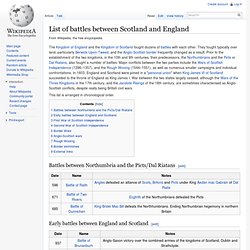
They fought typically over land, particularly Berwick-Upon-Tweed, and the Anglo-Scottish border frequently changed as a result. Prior to the establishment of the two kingdoms, in the 10th and 9th centuries, their predecessors, the Northumbrians and the Picts or Dal Riatans, also fought a number of battles. Major conflicts between the two parties include the Wars of Scottish Independence (1296–1357), and the Rough Wooing (1544–1551), as well as numerous smaller campaigns and individual confrontations.
In 1603, England and Scotland were joined in a "personal union" when King James VI of Scotland succeeded to the throne of England as King James I. Famous Scottish Battles. Mons Graupius - (84 AD) 10,000 Picts and 340 Romans killed when Calgacus fought Agricola.
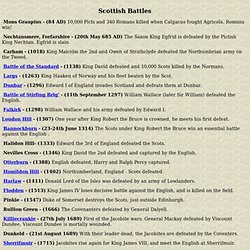
Romans win! Nechtansmere, Forfarshire - (20th May 685 AD) The Saxon King Egfrid is defeated by the Pictish King Nechtan. Egfrid is slain. Historic Scottish Battles - From Rampant Scotland. Battle of Aldearn - 1645While encamped at Auldearn, two miles from Nairn, the Duke of Montrose was surprised by a large force of Covenanters but fought back and defeated them.
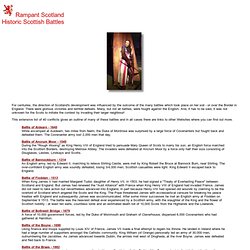
The Covenanter army lost 2,000 men that day. Battle of Ancrum Moor - 1545During the "Rough Wooing" as King Henry VIII of England tried to persuade Mary Queen of Scots to marry his son, an English force marched into the Scottish Borders, destroying Melrose Abbey. The invaders were defeated at Ancrum Moor by a force only half their size consisting of Douglases, Leslies, Lindsays and Scotts. Battle of Bannockburn - 1314An English army, led by Edward II, marching to relieve Stirling Castle, were met by King Robert the Bruce at Bannock Burn, near Stirling. The over-confident English army was soundly defeated, losing 3/4,000 men, Scottish casualties were light.
Battle of the Boyne - 1690Using finance and troops supplied by Louis XIV of France, James VII made a final attempt to regain his throne. Scottish Battles. Scottish Battles & conflicts Timeline. AD 603 Battle of Degsastan King Aedan of Dalriada attempted to extend the boundaries of his realm to the East across central Scotland but the Northumbrian King Aethelfrith defeated him at this battle at Degsastan (Addinston).
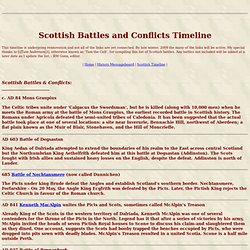
The Scots fought with Irish allies and sustained heavy losses on the English, despite the defeat. Addinston is north of Lauder. 685 Battle of Nechtansmere (now called Dunnichen) The Picts under king Brude defeat the Angles and establish Scotland's southern border. AD 841 Kenneth MacAlpin unites the Picts and Scots, sometimes called McAlpin's Treason. Historic Scotland Data Website - Battlefields. UK Battlefields - Scottish Battlefields In 2004-5, with a grant from Historic Scotland, the Battlefields Trust carried out an assessment of Scottish Fields of Conflict.
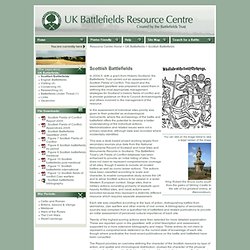
The report and the associated gazetteer was prepared to assist them in defining the most appropriate management strategies for Scotland’s historic fields of conflict and to provide guidance on this to Council Archaeologists and others involved in the management of the resource. In the assessment of individual sites priority was given to their potential as archaeological monuments, where the archaeology of the battle and battlefield offers the potential to develop a better understanding of the individual actions. Memorialization and related issues were not a primary objective, although data was recorded where incidentally identified. This was a desk based project working largely from secondary sources plus data from the National Monuments Record of Scotland and most Sites and Monuments Records in Scotland. The Official Gateway to Scotland. Brunanburh: The Battle that Created England.
In Britain one of the first things we learn in history lessons is the Norman conquest of England in 1066.
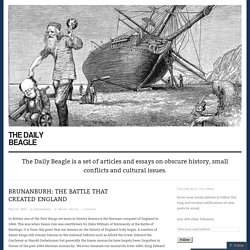
This was when Saxon rule was overthrown by Duke William of Normandy at the Battle of Hastings. It is from this point that our lessons on the history of England truly begin. A number of Saxon Kings still remain famous in the national folklore such as Alfred the Great, Edward the Confessor or Harold Godwinsson but generally the Saxon monarchs have largely been forgotten in favour of the post-1066 Norman monarchy. We even measure our monarchs from 1066, King Edward VIII (January-December 1936) should be called Edward X if we were to recognise the Saxon Kings.
It is ironic that, in a nation so enamored with monarchy, we have generally ignored the first true King of England: Æthelstan of the House of Wessex. Mons Graupius. Battle of Largs. Stirling Bridge. Falkirk. Bannockburn. Flodden.
Battle of Prestonpans. Culloden.